The Buzzards Bay Center, located at 114 Front Street in historic downtown New Bedford, is more than just the Coalition’s headquarters. It is a learning center, a community resource, and a model for environmentally responsible design. Built in 1832, the Buzzards Bay Center was renovated in 2010 using green features that help save energy and protect our local waters.
In addition to staff offices, the Buzzards Bay Center is home to the Richard C. Wheeler Bay Learning Center and the Croll Conference Room, a community meeting space.
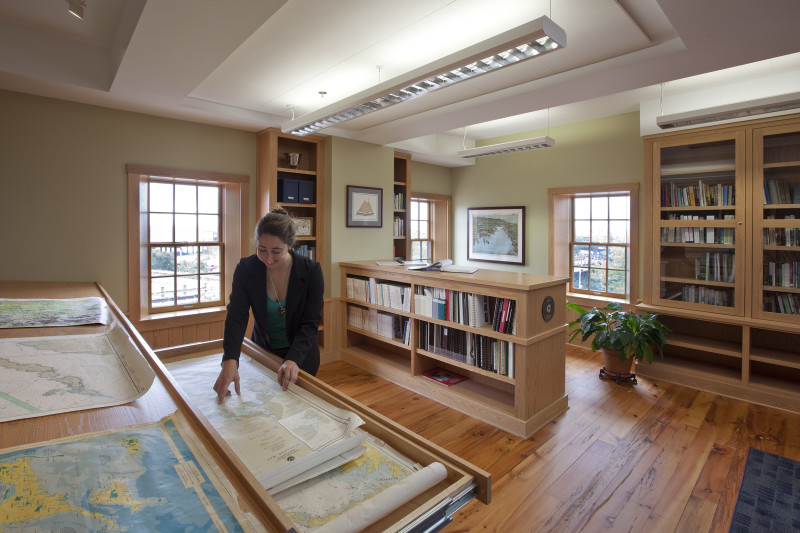
The Buzzards Bay Center has an extensive library with books, maps, videos, and other resources documenting the effort to save Buzzards Bay and other coastal waterbodies. (Image: Vanderwarker)
Buzzards Bay Center green features
The Buzzards Bay Center is a model for environmentally responsible building renovation. The center uses a number of “green” features that save energy and reduce polluted runoff. As a result, the Buzzards Bay Center uses less than one-third of the electricity of an average office building, which protects our environment.
From its location in a historic building to the plants and solar panels on the roof, the Buzzards Bay Center exemplifies the Coalition’s sense of responsibility to our land and water. These green features are cost-effective, proven techniques that any business or homeowner can use.
Location
Forests, marshes, and other important natural areas are dwindling because of poorly planned development. That’s why the Coalition renovated the Coggeshall Counting House – an existing space in the heart of downtown New Bedford – instead of constructing a new building.
By “reusing” this building, we saved important wildlife habitats, reduced the need for new materials, and invested in the future of New Bedford’s revitalized historic district.
Water Conservation
Water is at the very core of our work at the Buzzards Bay Coalition. To curb our own water use, the Buzzards Bay Center is outfitted with water-saving fixtures such as waterless urinals and low-flow toilets.
Vegetated Roof
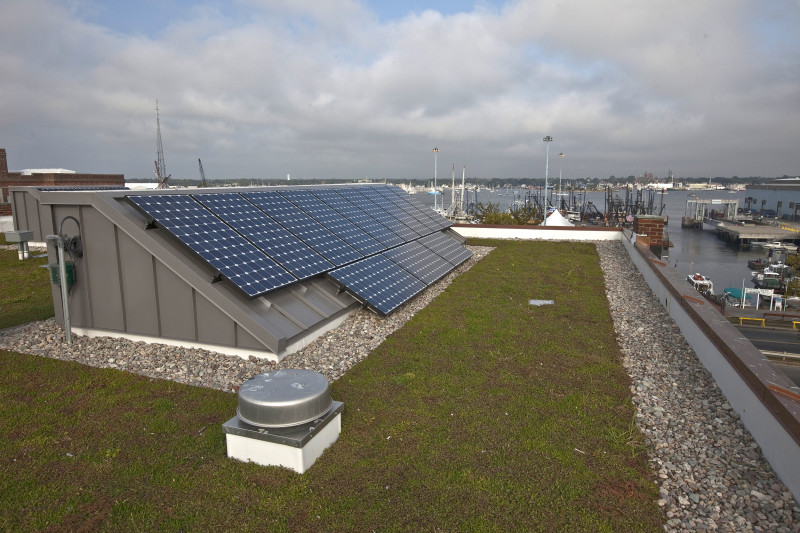
The green roof on the Buzzards Bay Center soaks up rain water before it can reach our streets and storm drains. It also has solar panels, which supply a portion of the building’s energy needs.
Perhaps the “greenest” aspect of the Buzzards Bay Center is its roof. Instead of a typical roof of tar and shingles, ours is covered with a four-inch carpet of plants and soil.
Plants on a roof may seem like a bad idea. But a green roof is actually a creative solution to a serious problem. It keeps the building cooler in the summer, saving energy. And the plants absorb rain during storms, which reduces polluted runoff from our building by more than 50 percent.
By stopping rain from flowing off our building, the Coalition is providing an important model for tackling stormwater runoff in New Bedford. The city’s local waterways suffer from pollution from Combined Sewer Overflows (CSOs), which dump raw sewage into the water during heavy rainstorms.
Daylighting
The Buzzards Bay Center takes advantage of natural daylight, which limits our need for artificial lighting. Skylights and lots of big windows with angled openings let sunlight pour into the building. And an open floor plan maximizes everybody’s access to natural light.
Renewable Energy
Natural light is nice, but we also put the sun to work. Solar panels on the roof convert the sun’s rays into electricity. These panels produce more than 8.25 kW of clean energy a year – supplying about one-fifth of the building’s total electricity needs.
Materials
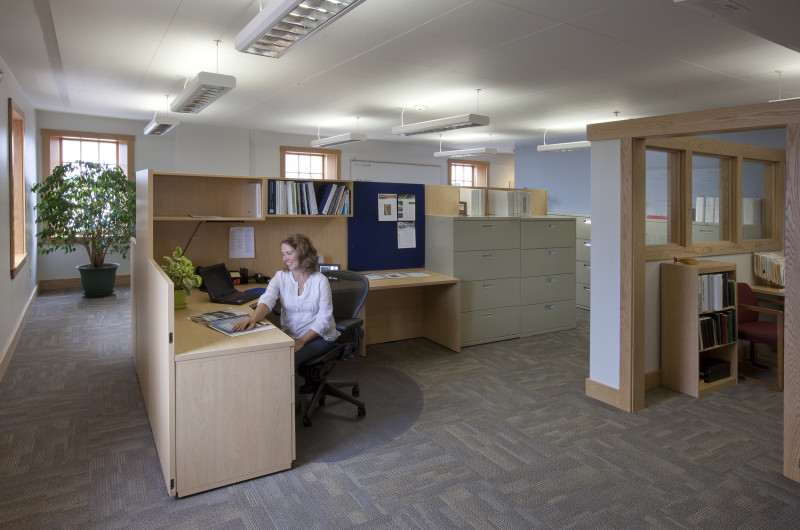
The offices at the Buzzards Bay Center use renewable, sustainable materials that are bathed in sunlight from special daylight-enhancing features. (Image: Vanderwarker)
Sustainable, local, and recycled – that was our checklist for building materials in the Buzzards Bay Center.
- Lumber was harvested from certified sustainable forests.
- Carpenters reused old timbers found in the building to create hardwood flooring.
- The carpets are made from recycled materials. They are completely recyclable themselves.
Building Envelope
The center’s most important energy-saving feature is buried deep in the walls. It’s insulation – dense foam that separates the interior walls from the exterior brick and granite. These thick, insulated walls keep heat in during the winter and out during the summer. In addition, every seam and crack was filled to keep drafty air from moving in and out of the building.
Mechanical Systems
Given the serious threats that fuel poses to Buzzards Bay – both as it is shipped through the Bay and as a result of global warming – the Coalition aims to minimize the use of fossil fuels at the Buzzards Bay Center.
With its tight building envelope, the center uses smaller, more efficient air-source heat pumps and energy recovery ventilation systems. In addition to being bright and sunny, the building’s interior spaces are comfortable and full of fresh air.
History of the Buzzards Bay Center
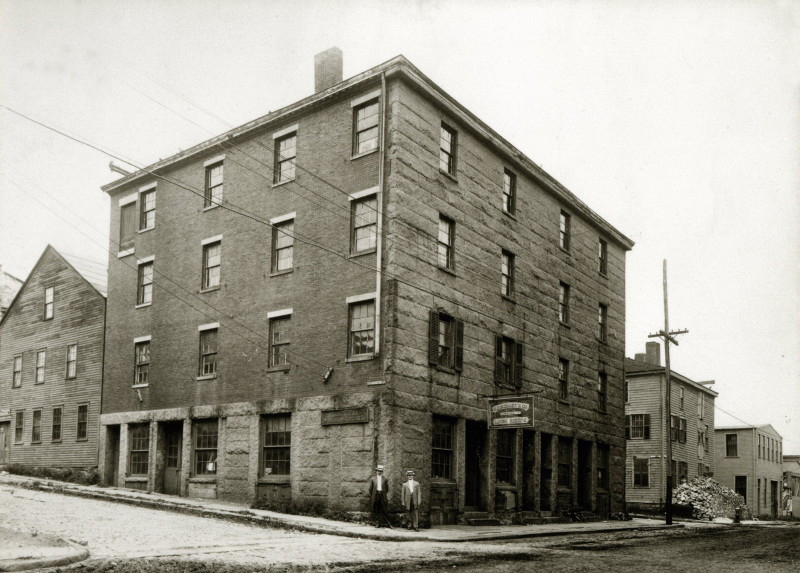
The Buzzards Bay Center was once the Coggeshall Counting House, an important building for the whaling industry in New Bedford.
Long before it was the Buzzards Bay Center, our building played an important role in New Bedford’s whaling history. After decades of neglect, the Buzzards Bay Coalition purchased and restored the building.
19th century: A center of the whaling industry as the Coggeshall Counting House
The Coggeshall Counting House was built in 1832 by John Coggeshall, Jr., a prominent merchant and ship owner in New Bedford.
The four-story building served New Bedford’s whaling industry. On the first floor, there was a chandlery where candles were made. The second floor housed counting rooms. The top floors served as space for sail and rigging lofts.
Because of its role in the whaling industry, the Buzzards Bay Center is today part of the New Bedford Whaling National Historical Park.
20th century: A neglected and deteriorating eyesore
As New Bedford’s whaling industry waned, so did the Coggeshall Counting House. A series of fires damaged the building, including one in 1939 that destroyed its roof. By the 1960s, the upper floors were burned out and vacant.
21st century: New life as the Buzzards Bay Center
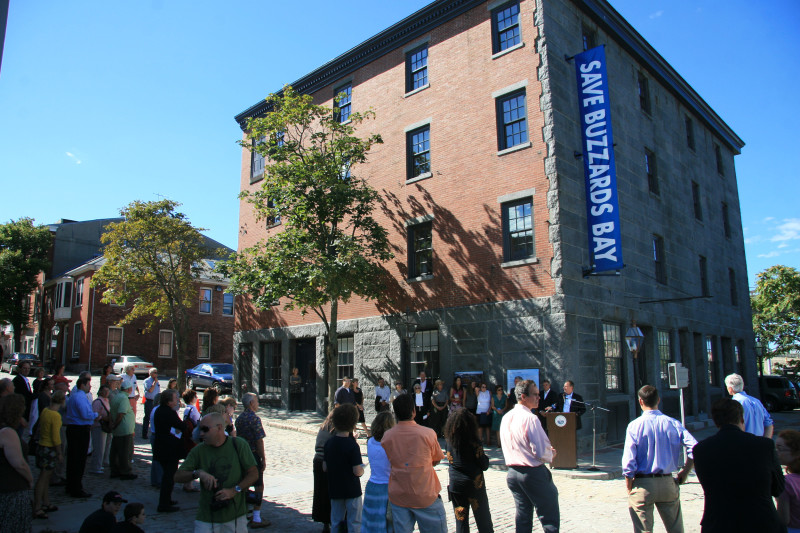
The Buzzards Bay Coalition opened its new headquarters in downtown New Bedford in August 2010
In the early 2000s, the Buzzards Bay Coalition was looking for a new home. Our staff was growing, and we wanted to create a community space where people could learn about Buzzards Bay. Instead of constructing a new building, we chose to find an existing place where we could move.
In 2008, we purchased the Coggeshall Counting House. Over the next two years, we renovated the building, honoring its past while creating a new, bright future.
- Architects restored the building’s façade to its former beauty. Using historical photos, they replicated the original doors, windows, and decorating molding.
- With lots of environmentally friendly features, the building saves energy and reduces pollution.
On August 26, 2010, the Coalition christened the former Coggeshall Counting House as the Buzzards Bay Center.
Awards for the Buzzards Bay Center
The Buzzards Bay Center has earned the following awards for its innovative combination of green design and historic renovation.
- The Cote Award from the American Institute of Architects (AIA) Maine chapter.
- The Massachusetts Preservation Award from the Massachusetts Historical Commission
- The George C. Perkins President’s Award from the Waterfront Historic Area League (WHALE), New Bedford’s preeminent preservation organization.
- The Elm Award from the New Bedford Preservation Society to honor outstanding preservation, restoration, or adaptive reuse of buildings in New Bedford.